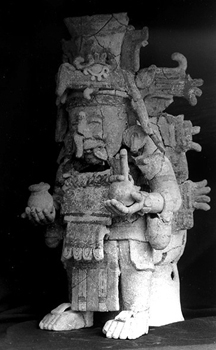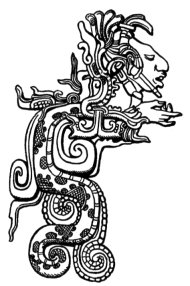
Mayan God Chaac
(Wiki Commons)
|
More
intriguing, however, is the ubiquitous iconographic presence of the
Mayan god "Chaac," god of rain and fecundation. Chaac has a
distinctly
elephantine appearance with a long nose and large, ponderous body. This
deity has been likened to the Hindu elephant deity "Ganesh," although
the two have
somewhat different influences in their respective cultures. Chaac's
nose or trunk, however, appears everywhere (see photo above right) and
has raised the question
of where ancient Mayans might have seen elephants, given that the
Columbian Mammoth is thought to have gone extinct several thoursand
years before the rise of Mesoamerican civilization. It seems
possible, since the Columbian mammoth roamed as far south as Honduras
at the
end of
the last ice age, that tribal memories of these
creatures could have been passed on through oral traditions and
drawings. They
might ultimately have been turned into deities in the Mesoamerican
consciousness. I have seen the well preserved remains of
Columbian Mammoths being unearthed from an ancient sinkhole in South
Dakota. These unfossilized remains, although thousands of years
old, still had
some of the hide intact along with bones and scat. The Yucatan
penninsula is honeycombed with sinkholes (called "cenotes") and
underground streams. These places were virtually the only sources
of
water for the Mayans who explored them extensively. Finding the remains
of Columbian Mammoths in association with their sacred water holes
would have reinforced their ideas about Chaac.
Less likely, although still possible, is the theory
that the Olmecs, Mesoamerica's earliest civilization, were a seafaring
culture that came originally from Africa and brought with them the
concepts of elephants as well as pyramids. These theories will probably
never be either confirmed or disproved, but the extent of
cultural diffusion and Mayan knowledge shouldn't be underestimated.
Contemporary Mayan scholars dismiss the end of the world hysteria that
has been stoked by the popular media in North America. The Mayan
calendar, they say, is simply like the odometer in your automobile,
except that this odometer is attached to the earth as it revolves
around the sun, and the sun revolves around the galactic center. After
so
many miles (and years) it turns over and begins again at zero. There is
nothing special about the end of time in the Mayan calendar they
say. Even so, the locals in Yucatan enjoy the attention it has
brought
them from North Americans who come to explore the ancient ruins, learn
about the Mayans and leave their dollars and pesos. Personally, I find
the Mayan's iconography and architecture distinctive, interesting
and
beautiful, which makes it a good subject for photography.
|


